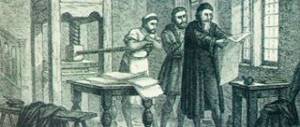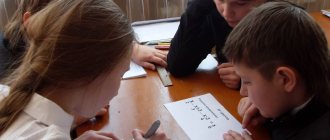How to insert a trigger into a presentation?
To answer this question, it is more convenient to turn to a simple example.
Step 1. Create two objects on the slide: a circle and a rectangle.
Let’s set ourselves the task of setting up the presentation so that when it starts, the circle immediately appears on the slide, and the rectangle appears only when you click on the circle (that is, we’ll create a trigger that will program the appearance of one shape when you click on a certain other shape).
Presentation for the lesson
Attention!
Slide previews are for informational purposes only and may not represent all the features of the presentation. If you are interested in this work, please download the full version. The purpose of the lesson: the formation of knowledge, skills and abilities in using triggers in the PowerPoint program, the possibility of practical application of the acquired knowledge.
Planned learning outcomes:
Subject: developing students’ ability to use triggers when creating presentations. Metasubject:
- developing the ability to create presentations to solve educational, real and life problems;
- developing competence in the use of ICT to present information and achieve results.
Personal: the formation of communicative competence in communicating with peers in the process of research and creative activity.
Lesson equipment:
- IBM PC computers with MS Windows 7 and MS Office 2010 operating systems;
- multimedia projector;
- presentation program on the topic of the lesson;
- Examples of slides using triggers.
Understanding triggers and their scope You can create various animation effects in PowerPoint. One such tool is a trigger.
A trigger is an animation tool that allows you to set an action or time condition for a selected element. In this case, the animation starts on click. Trigger translated from English means trigger, shutter. Using a trigger, you can set an action to any object. Moreover, we can choose the sequence of these actions depending on desire and situation. You can open a task as it is completed. Left-clicking an object animates it, causing it to perform a predefined action. The presence of triggers significantly increases the interactivity of the presentation.
Creating a slide with triggers
First we need to figure out what we want and create the slide itself. Let's say we want to select input devices from the suggested PC devices. The remaining devices should disappear when you click on them.
1. Assign devices other than input devices an exit animation (for example, “disappear”), and input devices – a highlight (for example, “swing”).
ADVICE. If you need to configure several objects at once, then press and hold Shift on the keyboard and select the desired objects with the left mouse button. By releasing Shift you can customize the animation. Next, all that remains is to set the necessary animation parameters.
2. In the Animation Area, click on the triangle and select Time in the window that appears.
3. In the window that appears, select Start by click. In the Switches area, check Start executing effect when clicked. When you select this line, you will be able to select the desired object. Click OK, the trigger is ready for one number. This is how we set up triggers for all objects.
After setting up all the triggers, the animation area looks like this:
4. There is a possibility of accidentally clicking the mouse past the configured trigger object. And then the slides will change to the next one. And there will be no opportunity to complete the task on the slide. To exclude this possibility, you need to uncheck the “On Click” slide changer. It is located in the “Animation” (Office 2007) or “Transitions” (Office 2010) tab.
You can configure a control button to move to another slide.
5. In Slide Show mode, check that the configured triggers are working correctly.
Creating a game using triggers
1. Present a clear picture of what we want to do. In our case, we need to find tablets with numbers that encode information into the PC and cure it. If the answer is incorrect, the number disappears; if answered correctly, it moves to the first aid kit.
2. Create a presentation. It is important that the tablets are separate elements. We immediately write correct and incorrect answers on the tablets.
In order for the animation to be configured simultaneously for the tablet and the number, we will create a grouping. Let's select the number and the tablet at the same time. To do this, you need to LMB-click on the tablet (it will be highlighted), and then, while holding Shift, LMB again on the number. You will get a simultaneous selection of the tablet and the number. Next, right-click to open the context menu. Select Group and Group again. If you use autoshapes, keep in mind that most of them are already configured for something to be written in them. Therefore, when using an autoshape, most often there is no need to perform grouping.
3. Setting up the animation. We will move the correct answers, building a path into the first aid kit, and the incorrect ones - the exit with scaling.
4. Set up triggers for all groups. We discussed how this is done in one of the previous topics.
5. In order to avoid accidental changing of slides, you need to disable Change of slides by click, i.e. uncheck the box next to By click.
The transition will be carried out by the control button (if you configure it) or by the transition arrow to the next slide (in the Slide Show mode at the bottom of the presentation). 6. It remains to check what we got in the Slide View mode.
Creating a test using triggers
Using triggers, you can easily create test tasks on various topics.
1. As always, we start with the idea and creation of a test. Our idea is that if the answer is correct, a smart owl will appear, and if the answer is incorrect, a thoughtful one will appear. Fill out the slide with all the necessary elements. Because There are 2 wrong answers, then there are also 2 “thoughtful owls”. We assign animation to the drawings - an input with a smooth approach.
Interactive game with triggers “Connoisseur of Folk Toys”
#Materials for teaching practice #Lesson self-analysis #Additional education teacher
Experts in folk toys Interactive game with triggers
Abstract Abstract This resource is intended for students of a creative association for clay modeling, according to the program “At the Origins of Craftsmanship.” The quiz game contains material that will help identify students’ knowledge about the folk toy. Can be used both in class and in extracurricular activities. For each correct answer the player will receive a token. The player who collects the most tokens wins. This player is awarded the title “Best Expert in Folk Toys.” The game is based on the action of triggers. The presentation was created in Microsoft Office Power Point 2003 format.
For each correct answer, the quiz participant puts a chip in his piggy bank: white - the traditions of craftsmen in making toys (shape), red - the traditions of craftsmen in making toys (painting), green - the ability to identify types of folk toys. For each correct answer, the quiz participant puts piggy bank chip: white - the traditions of craftsmen in making toys (shape), red - the traditions of craftsmen in making toys (painting), green - the ability to identify types of folk toys
There were a great variety of clay toys, very diverse. Different regions had their own characteristics of making clay toys - depending on local traditions, local clay. There were a great variety of clay toys, very diverse. Different regions had their own peculiarities of making clay toys - depending on local traditions, local clay I round. "Guessing Game"
The color is crimson and blue, Yellow is bright and beautiful. Hares, birds, cockerels - Musical whistles, Folklore - whistles. They sculpt their Tula region And whistles, no doubt, They conquered the whole world! Red stripe, Green stripe, Yellow stripe, Amazing little animals - These folk toys. Dymkovskaya Kargopolskaya Filimonovskaya OH!
These Vyatka toys are like a rainbow in the spring: Look, here is a turkey, Its tail is like a painted fan, Next to it is a beautiful young lady, Standing with her arms akimbo; Buffoons, water bearers, ladies and roosters - They are decorated with stripes, cages, dots and circles. Dymkovskaya Kargopolskaya Filimonovskaya OH! OH!
They work skillfully with clay. Their hands do not get tired. The master kneaded the clay and molded the toys. Then dried them, and into the oven - burn them all white. And then he took paints and painted the toys. Here they are in a row, Multi-colored: Here are the dogs, here is Polkan, Bearded centaurs And the funny Pull - Push! Whose toys? Did you guess right? Dymkovskaya Kargopolskaya Filimonovskaya OH! OH!
2nd round “Recognize by the form” Dymkovskaya Kargopolskaya Filimonovskaya
III round. “Choose an outfit for Cockerel” Oh! Oh!
5 Moscow Tver Arkhangelsk SMOLENSK Kirov Tula IV round. “Define the homeland of the toy”
V round “What an extra toy” True Think again
V round “What an extra toy” True Think again
True Think again
What three colors distinguish the palette of the Filimonov toy VI round. “Folk Painting Palette” Oh!
What colors do Dymkovo craftswomen use to paint toys?
bowl The skirt of a Dymkovo lady is called... cucumber tomato red white mortar One of the elements of Dymkovo painting is called... A Dymkovo toy is sculpted from clay... OH! OH! OH! VII round. "Play"
and , ki Toys VIII round. "Entertaining puzzle"
IX round. "Find the artist's mistake"
X round “Find signs of water and sun in the elements of Kargopol painting”
XI round. “Remember the name of the mythical Kargopol toy” Pull and push Polkan Bird Sirin




